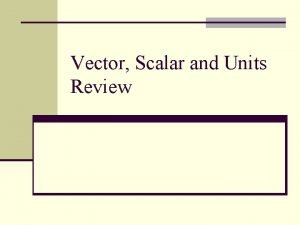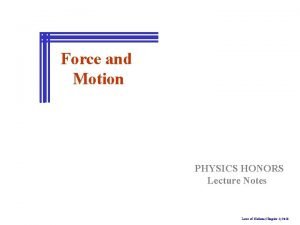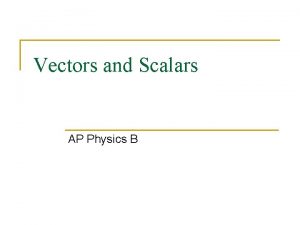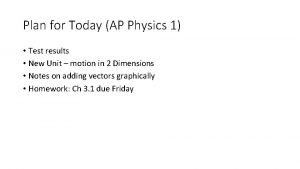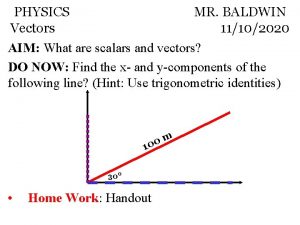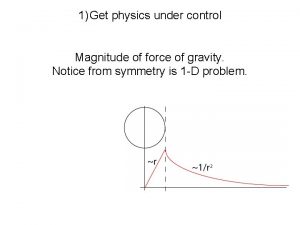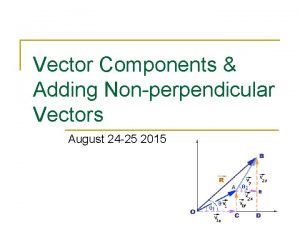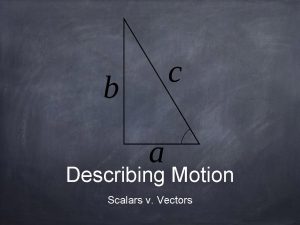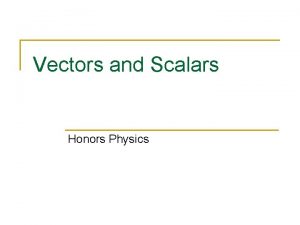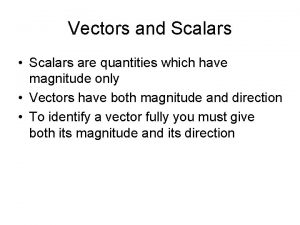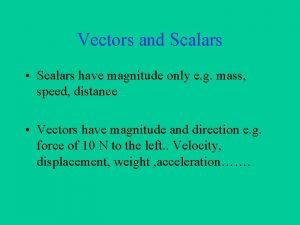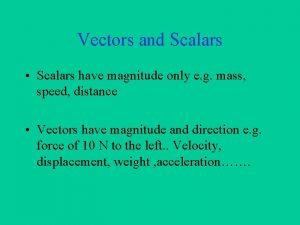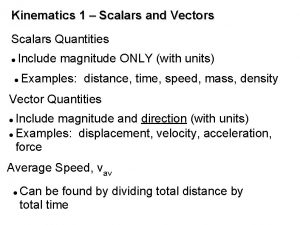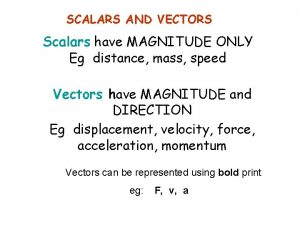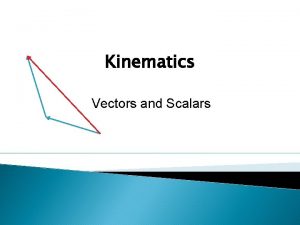MOTION Honors Physics Scalars vs Vectors Scalars are























- Slides: 23

MOTION Honors Physics

Scalars vs. Vectors • Scalars are quantities that only have a magnitude (number value) Examples: • 5 meters, 4000 calories, 40 Joules • Vectors are quantities that have BOTH magnitude and direction. Examples: • 30 meters/second East, 5 miles South

Distance vs. Displacement • Distance is a scalar quantity and refers to how much distance an object traveled during its motion. • Displacement is a vector quaintly that refers to the object’s overall change in position.

A physics teacher walks 4 meters East, 2 meters South, 4 meters West, and finally 2 meters North. What is the distance and displacement of the physics teacher?

Use the diagram to determine the resulting displacement and the distance traveled by the skier during these three minutes.

Use the diagram to determine the resulting displacement and the distance traveled by coach pacing back and forth along the sidelines.

Speed vs. Velocity • Speed is a scalar quantity that refers to how fast an object is moving. • Does NOT keep track of direction • Velocity is a vector quantity that refers to the rate at which an object changes its position. • Keeps track of direction

Calculating Average Speed Average Velocity • • D V T

Average Speed vs. Instantaneous Speed • Instantaneous Speed – The speed at any given instant in time. • Average Speed – The average of all instantaneous speeds; found by distance/time

A physics teacher walks 4 meters East, 2 meters South, 4 meters West, and finally 2 meters North. This entire motion lasted for 24 seconds. What is the average speed and the average velocity?

Use the diagram to determine the average speed and the average velocity of the skier during these three minutes.

POSITION TIME GRAPHS

Position vs. Time Graphs • The slope of a graph showing distance plotted overtime gives the velocity • The steeper the line, the greater the velocity.

Constant Velocity This position vs. Time Graph represents a car moving with constant, rightward velocity of 10 m/s.

Changing Velocity This position vs. Time Graph represents a car moving with rightward, changing velocity and speeding up.

Constant Velocity Positive Velocity Changing Velocity (acceleration) Positive Velocity

Slow, Rightward (+) Constant Velocity Fast, Rightward (+) Constant Velocity

Slow, Leftward (-) Constant Velocity Fast, Leftward (-) Constant Velocity



How to Calculate Speed Using a Position vs. Time Graph To determine speed from this graph, do the following: • Pick two points • Determine how much distance was covered between the two points • Determine how much time passed between the two points • Plug those numbers into the speed equation and solve

Ticker Tape Diagrams • The distance between dots on a ticker tape represents the object’s position change during that time interval. • A large distance between dots = the object was moving fast • A small distance between dots = the object was moving slow

Ticker Tape Diagrams • A changing distance between dots = a change in velocity (acceleration) • A constant distance between dots = a constant velocity
 Vectors and scalars in physics
Vectors and scalars in physics Mikael ferm
Mikael ferm A bear searching for food wanders 35 meters east
A bear searching for food wanders 35 meters east Distinguish between scalar and vector
Distinguish between scalar and vector Scalars and vectors
Scalars and vectors Multiplying or dividing vectors by scalars results in
Multiplying or dividing vectors by scalars results in Vectors form 3
Vectors form 3 Is mass a vector or scalar
Is mass a vector or scalar Honors physics projectile motion test
Honors physics projectile motion test Physics semester 1 review
Physics semester 1 review Physics honors notes
Physics honors notes Carl yaztremski
Carl yaztremski Ap physics vectors test
Ap physics vectors test A storm system moves 5000 km due east
A storm system moves 5000 km due east Graphical addition of vectors
Graphical addition of vectors Physics vectors
Physics vectors How to add non perpendicular vectors
How to add non perpendicular vectors In her physics lab melanie rolls
In her physics lab melanie rolls Extension of scalars
Extension of scalars Creighton university honors program
Creighton university honors program James scholar program
James scholar program Deped order no. 36, s. 2016
Deped order no. 36, s. 2016 Honors program ucsb
Honors program ucsb Honors biology ecology test
Honors biology ecology test







